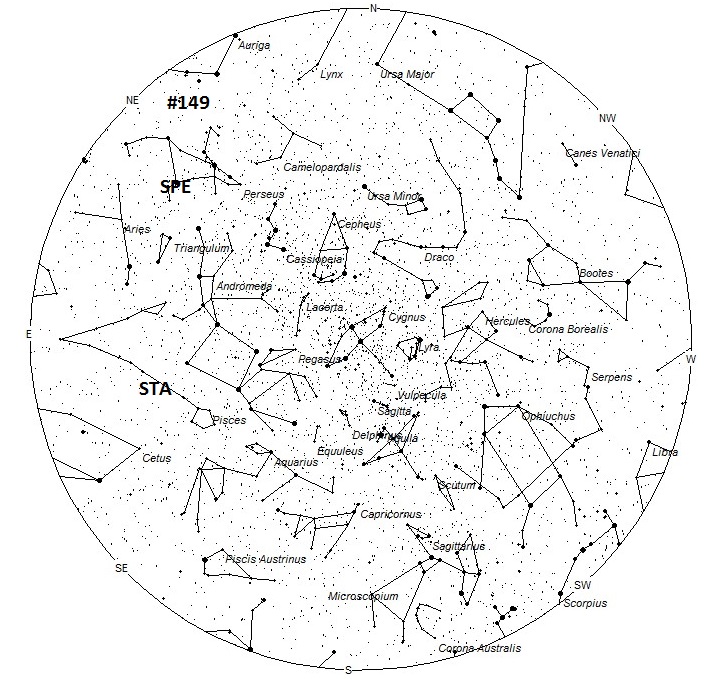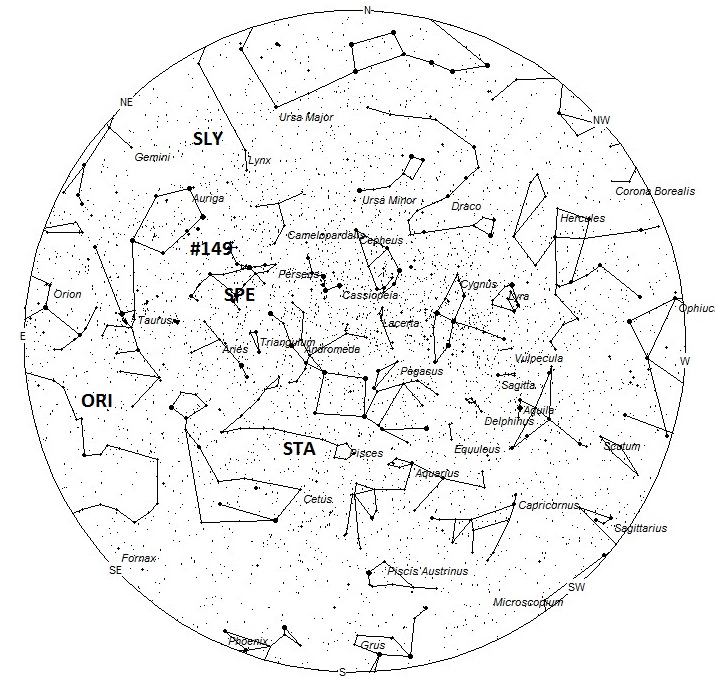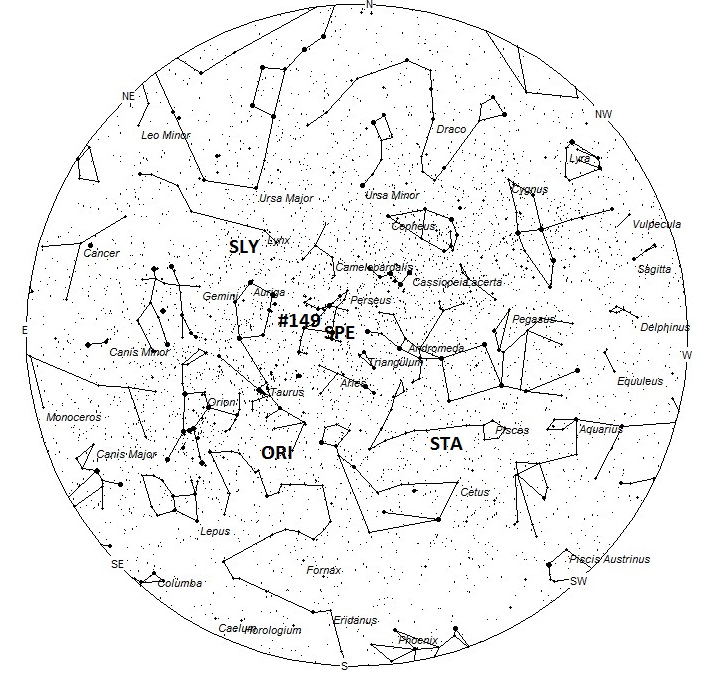During this period the moon reaches its first quarter phase on Thursday September 12th. At this time the moon is located ninety degrees east of the sun and will set near midnight local daylight time. This weekend the waxing crescent moon will set shortly after dusk and will not interfere with meteor observing. The estimated total hourly meteor rates for evening observers this week is near four for observers located in the northern hemisphere and three for those viewing south of the equator. For morning observers the estimated total hourly rates should be near twenty as seen from mid-northern latitudes and near thirteen for observers viewing from tropical southern latitudes. The actual rates will also depend on factors such as personal light and motion perception, local weather conditions, alertness and experience in watching meteor activity. Note that the hourly rates listed below are estimates as viewed from dark sky sites away from urban light sources. Observers viewing from urban areas will see less activity as only the brightest meteors will be visible from such locations.
The radiant (the area of the sky where meteors appear to shoot from) positions and rates listed below are exact for Saturday night/Sunday morning September 7/8. These positions do not change greatly day to day so the listed coordinates may be used during this entire period. Most star atlases (available at science stores and planetariums) will provide maps with grid lines of the celestial coordinates so that you may find out exactly where these positions are located in the sky. A planisphere or computer planetarium program is also useful in showing the sky at any time of night on any date of the year. Activity from each radiant is best seen when it is positioned highest in the sky, either due north or south along the meridian, depending on your latitude. It must be remembered that meteor activity is rarely seen at the radiant position. Rather they shoot outwards from the radiant so it is best to center your field of view so that the radiant lies at the edge and not the center. Viewing there will allow you to easily trace the path of each meteor back to the radiant (if it is a shower member) or in another direction if it is a sporadic. Meteor activity is not seen from radiants that are located below the horizon. The positions below are listed in a west to east manner in order of right ascension (celestial longitude). The positions listed first are located further west therefore are accessible earlier in the night while those listed further down the list rise later in the night.
The following sources of meteoric activity are expected to be active this week:
We are now encountering debris from comet 2P/Encke, which has a radiant superimposed upon the anthelion radiant. Since it has been shown that meteors from 2P/Encke are more numerous we shall recognize this activity as the Southern Taurids (STA) until December 5th, when the Earth no longer encounters these particles. The maximum was once thought to occur in early November when the radiant was located in Taurus. Video studies have shown that the peak usually occurs near October 10th but that there is also a period of enhancement during the last week of October and the first week of November, when the Northern Taurids are also active. The center of the large radiant is currently located at 00:20 (005) +03. This position lies in southern Pisces, seven degrees south of the fourth magnitude star Delta Piscium. These meteors may be seen all night long but the radiant is best placed near 0200 local daylight time (LDT) when it lies on the meridian and is located highest in the sky. Rates at this time should be near two per hour regardless of your location. With an entry velocity of 29 km/sec., the average Southern Taurid meteor would be of slow velocity.
New data for the September Epsilon Perseids (SPE) shows that this radiant is active from September 1st through the 28th with maximum activity occurring on the 9th. The radiant position is currently located at 03:00 (045) +40. This position lies in southwestern Perseus, very close to the famous eclipsing variable star known as Algol (Beta Persei). The radiant is best placed near 0500 LDT, when it lies highest above the horizon. Rates are expected to be near three per hour at maximum activity with the radiant located high in the sky. This shower experienced an outburst in 2008 with ZHR’s near 25 for a short time. Many bright meteors were produced during this outburst with the brightest estimated at magnitude -8. With an entry velocity of 66 km/sec., most activity from this radiant would be swift. This activity is visible from the tropical regions of the southern hemisphere, but further south the radiant becomes too low in the sky to produce much activity.
You may be surprised to see the Orionids (ORI) as an active radiant this time of year, but there is clear evidence from the IMO database that this shower is active long before its October 22nd maximum. In fact it is in the top four most active radiants throughout September. Expected rates this week are near three per hour no matter your location. This radiant is currently located at 04:16 (064) +04, which places it in southwestern Taurus, some twelve degrees southwest of the bright orange first magnitude star known as Aldebaran (Alpha Tauri). This area of the sky is best placed in the sky during the last hour before dawn, when it lies highest above the horizon in a dark sky. With an entry velocity of 67 km/sec., most activity from this radiant would be of swift speed.
A new, unnamed source of meteors active this weekend from a radiant located at 04:48 (072) +41. IMO shower #149 is active from August 29-September 9, with maximum activity occurring on September 3rd. The radiant is located in eastern Perseus, seven degrees southwest of the zero magnitude star known as Capella (Alpha Aurigae). This area of the sky is best placed in the sky during the last hour before dawn, when it lies highest above the horizon in a dark sky. Since we are well past maximum activity, rates would most likely be less than one per hour no matter your location. With an entry velocity of 70 km/sec., most activity from this radiant would be of swift speed.
Video studies by Molau and Rendtel has revealed a radiant active from September 7th-18th, with maximum activity occurring on the 9th. The radiant position on the 9th for the September Lyncids (SLY) is 06:22 (108) +56. This position lies in extreme northwestern Lynx some twelve degrees northeast of the second magnitude star known as Menkalinan (Beta Aurigae). This area of the sky is best placed in the sky during the last hour before dawn, when it lies highest above the horizon in a dark sky. Even at maximum activity hourly rates of only one are expected to be seen from the northern hemisphere. Due to the high northern declination this activity is not well seen south of the equator. With an entry velocity of 60 km/sec., most activity from this radiant would be of swift speed.
As seen from the mid-northern hemisphere (45N) one would expect to see approximately eleven sporadic meteors per hour during the last hour before dawn as seen from rural observing sites. Evening rates would be near three per hour. As seen from the tropical southern latitudes (25S), morning rates would also be near seven per hour as seen from rural observing sites and two per hour during the evening hours. Locations between these two extremes would see activity between the listed figures.
The table below presents a list of radiants that are expected to be active this week. Rates and positions are exact for Saturday night/Sunday morning except where noted in the shower descriptions.
| SHOWER | DATE OF MAXIMUM ACTIVITY | CELESTIAL POSITION | ENTRY VELOCITY | CULMINATION | HOURLY RATE | CLASS |
| RA (RA in Deg.) DEC | Km/Sec | Local Daylight Time | North-South | |||
| Southern Taurids (STA) | Oct 10 | 00:20 (005) +03 | 29 | 02:00 | 2 – 2 | II |
| September Epsilon Perseids (SPE) | Sep 09 | 03:00 (045) +40 | 66 | 05:00 | 3 – 1 | II |
| Orionids (ORI) | Oct 22 | 04:16 (064) +04 | 67 | 06:00 | 3 – 3 | I |
| IMO #149 | Sep 03 | 04:48 (072) +41 | 70 | 07:00 | <1 – <1 | IV |
| September Lyncids (SLY) | Sep 09 | 06:22 (108) +56 | 60 | 08:00 | 1 – <1 | IV |
 American Meteor Society
American Meteor Society



at approximately 6:45 this morning i saw and tried to get a picture of what looked to me to be a comet or something that looked very much like one. it was viewed from Gravette, AR in the western sky and moved rather quickly downward toward the south as it disappeared from my view within 6 or 7 minutes of the original sighting. There was too much light in the sky to get a picture of it to show on my cell phone camera and did not get the regular camera out in time to catch it. Was this what it looked like? have you had other reports?
Thank you for great information that I couldn’t find elsewhere. I live in Southwestern Oregon. This morning, between 12:15 am and 1:00 am (09/09/2013), I counted 14 meteors most shooting from slightly NE to slightly SW. They were brighter than what I had seen during the August Perseids. Your page is great. I had no idea there were any meteor showers tonight.
Again, thank you!
I just saw a bright greenish blue ball streaking across the South Atlanta sky. Can you confirm if this was a meteor.
Thank you,
Donna
I was wondering if someone knows whether or not this would be a September Epsilon Perseid
http://www.flickr.com/photos/rockyraybell/9709486534/
I live in east central Indiana and we saw sonething big and bright light up the western sky near the horizon on Friday, September 13, 2013. Could it have been debris from a comet A friend of mine took photos of it at dusk. We were able to see it for over an hour. I can send photos if you are interested.